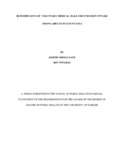| dc.contributor.author | Saye, Joseph O | |
| dc.date.accessioned | 2016-11-21T09:57:01Z | |
| dc.date.available | 2016-11-21T09:57:01Z | |
| dc.date.issued | 2016 | |
| dc.identifier.uri | http://hdl.handle.net/11295/97625 | |
| dc.description.abstract | Introduction: Randomized controlled trials have demonstrated that Medical Male Circumcision
offers upto 60% efficacy in the prevention of heterosexual HIV transmission. The Luo
community of Kenya do not practice traditional male circumcision and have been reporting the
highest HIV prevalence rates in Kenya. However, despite the concerted efforts to reach as many
eligible males as possible, the response has been below expectation particularly adults. We
sought to determine the extent of uptake and the factors associated with low uptake of Voluntary
Medical Male Circumcision among adult men in Luo Nyanza.
Methods: The study was a descriptive, cross sectional study with qualitative and quantitative
components targeting men aged 18 years and above. A total 384 respondents were interviewed
using structured questionaires and two Focus Group Discussions conducted. Data was organized
and presented using quantitative techniques; the Chi square, Z-test and Mann Whitney U-test
were used for testing for significance.
Results: The study found that only 58% of adult men had undergone cicumcision while the
remaing 42% had not. VMMC uptake was found to be highest among single respondents
(74.8%) and least among polygamous married respondents (30.0%), p-value <0.001, it was also
highest among respondents with 0 – 2 children (56.6%) and least (29.8%) among respondents
with more than 5 children, p-value=0.017. The unemployed also had the highest uptake (73.3%)
and least among self employed (52.2%), p-value=0.006
Conclusion: Circumcision was still unpopular among adults in Luo Nyanza and a significant
proportion of adult men have not opted for circumcision. Age, marital status, number fo children,
occupation and income are the key factors influencing the uptake of circumcision. There is a
linear decline in circumcision uptake with increase in age. In order to accelerate the uptake of
VMMC, intervention that targets the older males needs to factor in the household related factors
and the roles and responsibilities of such men at different age groups. | en_US |
| dc.language.iso | en | en_US |
| dc.publisher | University of Nairobi | en_US |
| dc.rights | Attribution-NonCommercial-NoDerivs 3.0 United States | * |
| dc.rights.uri | http://creativecommons.org/licenses/by-nc-nd/3.0/us/ | * |
| dc.subject | Male Circumcision | en_US |
| dc.title | Determinants of Voluntary Medical Male Circumcision Uptake Among Adults in Luo Nyanza | en_US |
| dc.type | Thesis | en_US |
| dc.description.department | a
Department of Psychiatry, University of Nairobi, ; bDepartment of Mental Health, School of Medicine,
Moi University, Eldoret, Kenya | |



